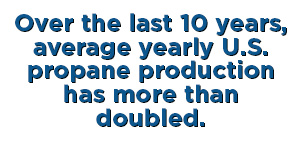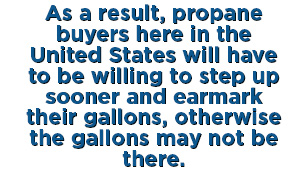 The last few years have brought significant changes to both domestic and global propane markets. United States propane production has been increasing at a record pace, but those additional gallons aren’t staying in the U.S. Propane exports are also on the rise, and Midwest producers have been investing in new pipeline infrastructure to expand export options and achieve more consistent demand throughout the year.
The last few years have brought significant changes to both domestic and global propane markets. United States propane production has been increasing at a record pace, but those additional gallons aren’t staying in the U.S. Propane exports are also on the rise, and Midwest producers have been investing in new pipeline infrastructure to expand export options and achieve more consistent demand throughout the year.
For U.S. retailers and wholesalers, a more global propane market is likely to change how and when they buy. They may have to make commitments sooner in order to secure adequate supplies and protect against price risk.
Exports on the rise
Over the last 10 years, average yearly U.S. propane production has more than doubled. By the end of December 2019, the U.S. achieved a record 2.46 million barrels per day (bpd) of production. Over that same 10-year period, U.S. propane exports increased nearly tenfold, hitting a weekly all-time high of liquid petroleum gas (LPG) exports of 1.74 million bpd in March 2020.
“That number illustrates how U.S. LPG exports have become a key driver of market demand,” says Dennis St. Aubin, CHS Propane western sales director. “The current U.S. market is now in a position to easily export two-thirds of the propane produced here.”
 Initially, the increase in exports created a growing market opportunity for Gulf Coast propane producers, and land-locked Midwest producers were left out, he adds. But over the past few years, Midwest-based producers have made significant investments in two new pipelines.
Initially, the increase in exports created a growing market opportunity for Gulf Coast propane producers, and land-locked Midwest producers were left out, he adds. But over the past few years, Midwest-based producers have made significant investments in two new pipelines.
The 530-mile Arbuckle II pipeline runs from Oklahoma through Texas and will reroute what was once Conway-focused supply into the greater Mt. Belvieu region near the Gulf of Mexico. The Bluestem pipeline extends from Conway, Kan., 188 miles to Kingfisher, Okla., tying into the Grand Prix NGL Pipeline there. Combined, the two pipelines have an unfractionated natural gas capacity of 620,000 bpd that can be moved into the export market. Read more about the impact of this build-out in a recent LPGas article.
More focus on supply
With as much as two-thirds of U.S. propane production now being exported, there will be less product in storage without a supply commitment, notes St. Aubin. “Propane producers are going to sell their product into the most profitable market and where they have buying commitments. That’s why we’ve seen export volumes rise.
“As a result, propane buyers here in the United States will have to be willing to step up sooner and earmark their gallons; otherwise the gallons may not be there.”

Photo: CHS
Retailers will need to put more focus on managing their price and supply risk by developing a diverse supply plan, he says.
“A key part of that supply plan is working closely with your wholesaler to position sufficient gallons,” says George Lipford, CHS Propane eastern sales director. He likens the new global market to a game of musical chairs. “There’s only a limited number of chairs. When demand picks up, everyone needs a chair, and markets can become volatile. Prices can spike and wet premiums start to appear.”
Tips for supply and price planning
 In today’s changing propane market, retailers need to transition from being primarily price-focused to better understanding their supply risks, says Lipford. “That makes having a supply plan essential.”
In today’s changing propane market, retailers need to transition from being primarily price-focused to better understanding their supply risks, says Lipford. “That makes having a supply plan essential.”
He and St. Aubin offer the following tips for year-long supply and price planning.
April through August:
- Develop a strategic supply and procurement plan. Review historical propane volumes by terminal and include any anticipated growth for the next year. Establish a target for procured volume that meets the company’s risk policy.
- Benchmark your goals. Regularly check in with your CHS Propane account manager to measure progress compared to the prior established contract volume goals.
September through March:
- Review and revise your plan. Frequent review is crucial to staying on top of the markets and ensuring adequate supplies. The CHS Propane Control Room is a convenient supply planning tool for customers that simplifies the process.
- Communicate with suppliers. Supply and procurement plans are a work in progress and require regular communication with your CHS Propane account manager. Your account manager can help in assessing market developments and making necessary adjustments.
- Diversify supply sources. Use multiple terminal modes, including pipelines, rail terminals and gas plants, if available, to provide flexibility in dealing with unexpected infrastructure problems.
- Glean market intelligence. Reliable suppliers are often one of the best sources of market intelligence and industry insights, which can help provide a broader view of events impacting the industry beyond your market. One great example is the daily Market Pulse bulletin provided by CHS Propane. Sign up for Market Pulse through CHS Propane Insights
Propane marketers should work with their CHS account managers for help with tracking industry trends and developing a supply plan that incorporates these strategies for reducing risk and meeting procurement needs. Those interested in partnering with CHS Propane can learn more by visiting CHS Propane Insights or by calling 1-800-852-8184.
This page was produced by North Coast Media’s content marketing staff in collaboration with CHS Propane. NCM Content Marketing connects marketers to audiences and delivers industry trends, business tips and product information. The LP Gas editorial staff did not create this content.
Header photo: CHS Propane













